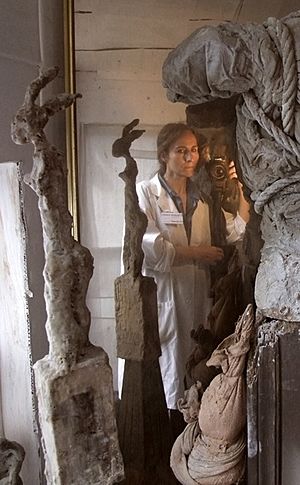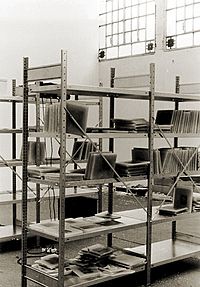Iris Häussler facts for kids
Quick facts for kids
Iris Haeussler
|
|
|---|---|

Haeussler in one of the rooms of her installation "The Legacy of Joseph Wagenbach" (2006)
|
|
| Born | 6 April 1962 Friedrichshafen, Germany
|
| Education | Academy of Fine Arts, Munich (Heribert Sturm) |
| Known for | Conceptual artist, installation artist |
|
Notable work
|
ou topos – Wien (1989), Pro Polis (1993), The Legacy of Joseph Wagenbach (2006), The Sophie La Rosière Project (2016), Florence Hasard (2018) |
Iris Haeussler (also spelled Häussler in German) is a German-born artist who creates conceptual art and installation art. She was born on April 6, 1962, and now lives in Toronto, Canada.
Many of Iris Haeussler's artworks are very detailed and look incredibly real. They are often like puzzles or stories that visitors can explore and figure out. Her art often explores themes like history, culture, family connections, memories, and strong feelings.
Contents
About Iris Haeussler
Iris Haeussler studied art at the Academy of Fine Arts, Munich in Germany. Her studies focused a lot on working in the studio and trying out new ideas. She was encouraged to explore and experiment with her art.
She received several awards and scholarships for her work, including a scholarship from the German Academic Scholarship Foundation. In 1999, she was a guest professor at the Munich Academy. Before moving to Toronto, Canada, in 2001, Haeussler showed her art in many places across Europe.
Even though she trained as a conceptual artist and sculptor, her art is hard to put into just one category. She has had shows featuring drawings and sculptures, as well as art that people can interact with. However, her most famous works are large, immersive installations. These are art pieces that you can walk into and experience all around you.
Amazing Hyper-Real Art Installations
Iris Haeussler's "hyper-real" installations create lifelike situations for made-up characters. These characters often live in ways that are very focused, almost like an obsession. Haeussler calls these major installations "Synthetic Memories." She means that she creates these memories from her research, ideas, and studio work, rather than just analyzing existing ones.
These projects often take years to create. They feel very real because she pays close attention to every detail of the specific place where the art is shown. They are also always shown in unusual places, not in typical art galleries.
At first, she tried to make her art seem less like "art." She created environments that looked like they were built and then left behind by people who were very focused on something. In her more recent projects, she includes the process of her research and how she sets up the art in the final display.
- Ou Topos – Vienna (1989): This was one of her first apartment installations. She recreated the home of an old man in a social housing building in Vienna, Austria. The main part of the art was a bedroom filled with thousands of tin cans of food. These cans were stacked on wooden shelves, wrapped in lead foil, and labeled with their expiry dates. Visitors could explore the space on their own. Haeussler actually lived in the apartment for six months to make the art feel truly real.
- Pro Polis (1993): For this project, Haeussler took over a hotel room in Milan, Italy. She covered the walls, floor, window, and everything else in the room with a thick layer of wax. Visitors could get the key from the hotel front desk and explore the waxy room by themselves.
- Huckepack (1995: Piggyback): This was another hotel project in Leipzig, Germany. Haeussler placed the personal items of a made-up traveling woman into a hotel room. Guests were offered this room if they agreed to share the space with this imaginary person. They would find an unmade bed, pajamas, and an open suitcase, making it feel like someone was really there.
- Monopati (2000): This project involved two apartments in two different cities, Munich and Berlin, Germany. Each apartment told a different story, but they were connected by one old school photograph from the late 1930s that was visible in both places. Visitors could get the keys from nearby art galleries and explore the apartments on their own.
- The Legacy of Joseph Wagenbach (2006): This was Iris Haeussler's first big project in North America and her largest at the time. It was set up in an entire house in downtown Toronto. The art told the story of an old, reclusive artist named Joseph Wagenbach. An archivist (often Haeussler herself) was on-site to help visitors understand the story. At first, the project was presented as a real assessment by the "Municipal Archives," not as an artwork. This led to some debate because people thought it was real history, not fiction. However, this surprise was a key part of the artwork itself.
- The Joseph Wagenbach Foundation (2015-present): This is a long-term project that continues the story of Joseph Wagenbach. It's a made-up foundation for a made-up artist, but the artworks it presents are real. The foundation offers small bronze sculptures and drawings to the public.
- He Named Her Amber (2008–2010): This installation was at The Grange in Toronto. Haeussler created the character of Amber, a 19th-century Irish maid who secretly lived a passionate life. A made-up company called Anthropological Services Ontario (also created by Haeussler) pretended to dig up artifacts at the historic site. Guided tours showed visitors Amber's personal items, which she had hidden in beeswax under the floorboards of the mansion.
- He Dreamed Overtime: All Our Relations (2012): This project was part of the 18th Biennale of Sydney. Haeussler created a story about a former park ranger who was sad about a lost love. He made strange, coral-like objects out of beeswax. The story then involved a pest-control company investigating the case. The company manager became so interested that he started to recreate the ranger's work and even created a blog about it.
- Ou Topos – Abandoned Trailer Project (2012): This was created for the "Nuit Blanche" (White Night) festival in Toronto. Haeussler revisited her first "Ou Topos" installation. She invented a grandson of the original character, a young survivalist who was researching nuclear fallout. He secretly set up his experimental lab-like trailer in an underground garage of Toronto City Hall.
- Sophie La Rosière Project (2016–2022): This project presented the life and art of a made-up French female artist from the early 20th century, Sophie La Rosière. It was shown in chapters. Chapter I introduced her life and showed a recreation of her art studio. Chapter II looked at her artworks using X-ray analysis and included video interviews with experts discussing if her work was real. Chapter III simply showed her artworks.
- Florence Hasard (2017–2022): This project expanded on the Sophie La Rosière story. It explored the life of Florence Hasard, a made-up character who was Sophie La Rosière's former lover. This story moved from France to the United States and explored Hasard's own art and the complex relationship between the two women.
- Seventeen Grams Of Longing (2024): The title of this project refers to the average weight of a migrating songbird. The art focused on the lives of birds and the fictional story of twin brothers, Kurt and Carl Pfister. The theme of migration connected everything, exploring the dangers faced when traveling to new places, especially birds hitting windows. The project included etched windows with bird shapes, paper bird cutouts, bird X-rays, gilded bird nests, and immersive displays.
Other Artworks
- Archivio (1991): This project took place during an art festival in Milan. Haeussler encased international newspaper clippings in hundreds of thin wax slabs. She then arranged them on steel shelves. Visitors could look through the slabs, rearrange them, and even break some. Over time, the organized archive became a collection of disorder. Haeussler has continued to use wax in her art, encasing things like children's laundry or fabric to create unique pieces.
- Paidi (1994): This art show in Munich, Germany, featured over 200 passport-sized photos of babies from 1905 to the present. Next to them were 280 samples of mother's milk that the artist had collected. The installation explored how where you live, your social situation, and history shape a person's life from the very beginning.
- Leihgaben (1995: On Loan): For this project, Haeussler collected laundry, pillowcases, and bed sheets from places like an orphanage, a hospital, and a prison. She took them out of their usual use for a short time to display them. One person in a nursing home was proud to have their nightgown shown in the exhibition. This shows how her art often involves people's real lives and stories.
- Xenotope (1994, 1997, 1998, 2000): This was a series of projects that offered temporary overnight stays. The first "Xenotop" in Leipzig was a simple room with a bed, desk, TV, towels, and bottled water, all painted light gray. Visitors could get a key from the gallery and spend one night there without any instructions or observation.
- Repla©e (1997): This project was a response to an invitation for a "Blind Date" with another artist. Instead of going herself, Haeussler sent a scientist in her place. The scientist filled a large studio with scientific drawings on chalkboards. This project caused some discussion because it made people think about how much an artwork's acceptance depends on knowing who the artist is.
- Honest Threads (2009): This installation was set up in a unique department store in Toronto called Honest Ed's. It featured a room with framed photographs and personal stories about clothes, contributed by people from Toronto. Visitors could borrow the clothes and wear them for a few days, experiencing what it felt like to "walk in someone else's shoes."
- Bonavista Biennale (2017): For this event in Newfoundland, Canada, Haeussler showed "Dust at Dawn." This piece consisted of large sheets of mylar (a type of plastic film) with double-sided tape. The tape held dust collected from cracks, door and window frames, lint from carpets, and dead flies from the floors of a historic house in the area.
Made-Up Organizations in Her Art
Iris Haeussler sometimes creates made-up organizations or companies as part of her art projects. These organizations act as if they are real, investigating and presenting discoveries before the public realizes they are actually artworks.
- The Municipal Archives, Toronto (a fictional organization)
- The Anthropological Services Ontario (a fictional organization)
- Pest Control Sydney (a fictional organization)
- The Joseph Wagenbach Foundation (a fictional organization)
See also
- Conceptual art
- Installation art
- Superfiction
Images for kids



